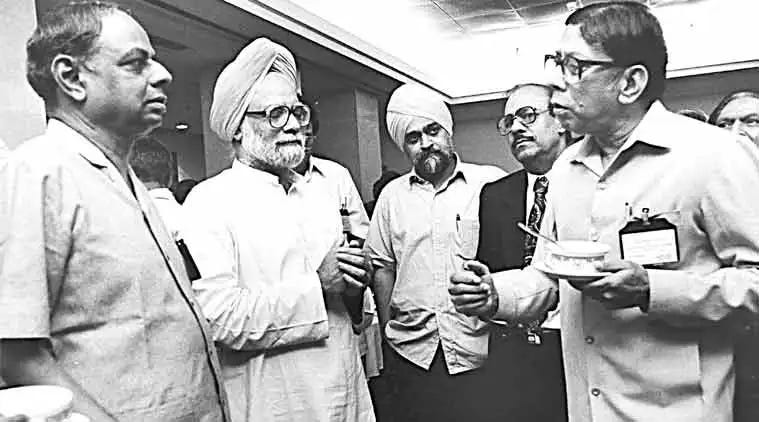
My generation distinctly remembers an era of acute financial turbulence: a time when cooking gas cylinders were rationed, a landline phone was a symbol of affluence, and the mere thought of owning a car seemed like an unattainable fantasy. Purchasing a home felt like an impossible dream, with housing loans rarely extended, all compounded by a highly unstable political landscape.
Amidst this pervasive instability, the Indian economy cried out for a radical change. It was then that Prime Minister Narasimha Rao, empowering his Finance Minister, the esteemed economist Dr. Manmohan Singh, initiated the pivotal Reforms of 1991. This bold economic overhaul completely transformed India's economic trajectory, paving its way to becoming a dominant financial force on the global stage. Montek Singh Ahluwalia was one of the key players in Dr Manmohan Singh’s Team. He shared his experiences of that period in his book “Backstage : The Story behind India’s High Growth Years”.
“Backstage” is not your typical memoir. Instead, it’s a vibrant travelogue through the corridors of power, policy, and pivotal moments that shaped modern India. As an insider for over three decades, Ahluwalia offers a ringside view of the reforms, the drama, and the human stories that made history. Let’s dive into some of the most fascinating incidents and anecdotes from the book! 📖✨
1. Infosys and the Saga of the Imported Computer 💻
In 1983, Infosys, then a fledgling IT company, wanted to import a cutting-edge Data General MV/8000 computer. Sounds simple? Not in pre-liberalization India! N.R. Narayana Murthy and his team had to make multiple trips to Delhi just to secure the import licence. By the time they got it, technology had already moved on-a newer, cheaper model was available! But because the licence specified the exact model, more bureaucratic hurdles awaited.
The real twist came at Bangalore customs. Infosys was eligible for a reduced import duty, but the customs officer hinted at a bribe. Infosys refused, and the officer slapped an extra ₹10 lakh duty on a technicality. Infosys chose integrity, paid up, and fought the case for nine years-finally winning on appeal. This incident is a classic example of how red tape and discretionary power can stifle innovation and entrepreneurship. Talk about patience and perseverance! ⏳🙌
2. Maruti, Dr. V Krishnamurthy, and the People’s Car 🚗
Maruti Udyog Ltd (MUL) was born from Sanjay Gandhi’s vision of an affordable car for the masses. The idea faced stiff resistance-automobiles were seen as a luxury, and many in the government thought resources should go elsewhere. Enter Dr. V. Krishnamurthy, a seasoned public sector manager who took the helm after Mrs. Gandhi promised him full autonomy.
Krishnamurthy’s realism was refreshing: he told Mrs. Gandhi that while India could manufacture a car, it could not design one from scratch. This openness led to a more liberal approach to importing technology. He also insisted on a significant equity stake for Suzuki to insulate Maruti from political meddling-an inspired move that ensured long-term commitment and stability.
The Maruti story is also about scale: Krishnamurthy broke with tradition by demanding a licence to produce 100,000 cars a year, making the car truly affordable. His insistence on managerial autonomy and a pragmatic approach to foreign partnerships changed the face of Indian industry. 🚙💡
3. The IMF, the “M Document,” and the 1991 Crisis 💸
India’s 1991 balance of payments crisis is legendary, but Ahluwalia reveals the drama behind the scenes. As foreign exchange reserves dwindled to just two weeks’ worth of imports, panic set in. A mistaken report about an SBI default triggered a rush to advance the rupee devaluation-showing how fragile confidence can shape policy decisions overnight.
Earlier, Ahluwalia’s own “M Document”-a note advocating market reforms-sparked controversy within the Planning Commission. The leak of this document highlighted the deep divide between old-school self-reliance and the new vision of a globally integrated, market-driven economy. The tension between continuity and change was palpable, and the stakes couldn’t have been higher. 🔥📉
4. The Swraj Paul Affair: Corporate Drama Unfolds 🏢
The Swraj Paul episode exposed the soft underbelly of Indian capitalism. Paul’s attempt to take over companies controlled by families with minimal equity shook the business world. It revealed regulatory weaknesses and forced business families to increase their stakes, setting the stage for better corporate governance. The drama was real, and the lessons were lasting! 🕵️♂️📈
5. Personal and Political Crossroads: 1984 and Beyond 🕊️
The events of 1984 were deeply personal for Ahluwalia, a Sikh. His wife, Isher, played a pivotal role in mobilizing prominent Sikhs to rebuild trust after the riots. It’s a moving reminder that economic policy is always intertwined with the social fabric-and that healing and trust are as important as growth. ❤️🤝
6. The Telecom Revolution and the Aadhaar Leap 📱🔗
The book also highlights how the telecom revolution enabled financial inclusion and how visionaries like Nandan Nilekani (inducted into the Planning Commission) spearheaded the Aadhaar project. These initiatives transformed the way Indians connect, transact, and access services-proof that bold ideas can change millions of lives. 🌐🔖
7. Scandals, Protests, and the Power of Public Opinion 🗣️
From the 2G spectrum controversy to the India Against Corruption movement, Ahluwalia doesn’t shy away from the messy side of policy. He describes how allegations, media narratives, and public protests shaped the fate of governments and policies. The lesson? Transparency and communication are as crucial as good intentions. 📰⚖️
Final Thoughts: Lessons from the Backstage 🎭
Ahluwalia’s Backstage is a masterclass in how policy, politics, and people intersect. It’s full of fascinating incidents-some dramatic, some inspiring, all instructive. Whether it’s the doggedness of Infosys, the vision of Maruti, or the high-wire act of managing crises, the book offers a rare glimpse into the engine room of India’s economic miracle.🌟
What’s your favorite backstage moment from India’s economic journey? Share in the comments! 👇



